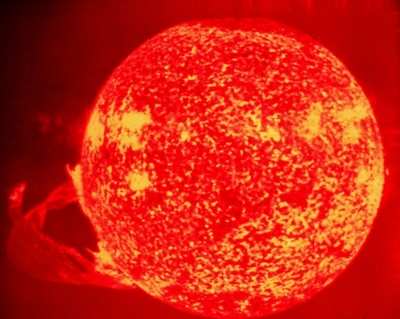A NASA-funded study describes how extreme solar eruptions could
have severe consequences for communications, power grids and other
technology on Earth. The National Academy of Sciences in Washington
conducted the study. The resulting report provides some of the
first clear economic data that effectively quantifies today's risk
of extreme conditions in space driven by magnetic activity on the
sun and disturbances in the near-Earth environment. Instances of
extreme space weather are rare and are categorized with other
natural hazards that have a low frequency but high
consequences.

"Obviously, the sun is Earth's life blood," said Richard Fisher,
director of the Heliophysics division at NASA Headquarters in
Washington. "To mitigate possible public safety issues, it is vital
that we better understand extreme space weather events caused by
the sun's activity."
Besides emitting a continuous stream of plasma called the solar
wind, the sun periodically releases billions of tons of matter
called coronal mass ejections. These immense clouds of material,
when directed toward Earth, can cause large magnetic storms in the
magnetosphere and upper atmosphere. Such space weather can affect
the performance and reliability of space-borne and ground-based
technological systems.
Space weather can produce solar storm electromagnetic fields
that induce extreme currents in wires, disrupting power lines,
causing wide-spread blackouts and affecting communication cables
that support the Internet. Severe space weather also produces solar
energetic particles and the dislocation of the Earth's radiation
belts, which can damage satellites used for commercial
communications, global positioning and weather forecasting. Space
weather has been recognized as causing problems with new technology
since the invention of the telegraph in the 19th century.
A catastrophic failure of commercial and government
infrastructure in space and on the ground can be mitigated through
raising public awareness, improving vulnerable infrastructure and
developing advanced forecasting capabilities. Without preventive
actions or plans, the trend of increased dependency on modern
space-weather sensitive assets could make society more vulnerable
in the future.

NASA requested the study to assess the potential damage from
significant space weather during the next 20 years. National and
international experts from industry, government and academia
participated in the study. The report documents the possibility of
a space weather event that has societal effects and causes damage
similar to natural disasters on Earth.
"From a public policy perspective, it is quite significant that
we have begun the extremely challenging task of assessing space
weather impacts in a quantitative way," said Daniel Baker,
professor and director of the Laboratory for Atmospheric and Space
Physics at the University of Colorado in Boulder. Baker chaired the
panel that prepared the report.
"Whether it is terrestrial catastrophes or extreme space weather
incidents, the results can be devastating to modern societies that
depend in a myriad of ways on advanced technological systems," said
Baker. "We were delighted that NASA helped support bringing
together dozens of world experts from industry and government to
share their experiences and begin planning of improved public
policy strategies."

The sun is currently near the minimum of its 11-year activity
cycle. It is expected that solar storms will increase in frequency
and intensity toward the next solar maximum, expected to occur
around 2012.
The Heliophysics Division of NASA's Science Mission Directorate
in Washington provided funding for the study. The division seeks to
understand the sun, its solar processes and the interaction of
solar plasma and radiation with Earth, other planets and the
universe. Understanding the connections between the sun and its
planets will allow better prediction on the impacts of solar
activity on humans, technological systems and even the presence of
life itself in the universe.
The National Academies are chartered by Congress to provide
independent technical and scientific advice to the federal
government.
 ANN's Daily Aero-Linx (04.15.24)
ANN's Daily Aero-Linx (04.15.24) Classic Aero-TV: 'No Other Options' -- The Israeli Air Force's Danny Shapira
Classic Aero-TV: 'No Other Options' -- The Israeli Air Force's Danny Shapira Aero-News: Quote of the Day (04.15.24)
Aero-News: Quote of the Day (04.15.24) Airborne 04.16.24: RV Update, Affordable Flying Expo, Diamond Lil
Airborne 04.16.24: RV Update, Affordable Flying Expo, Diamond Lil ANN's Daily Aero-Term (04.16.24): Chart Supplement US
ANN's Daily Aero-Term (04.16.24): Chart Supplement US





